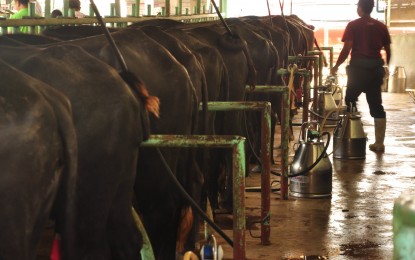
MILK SUPPLY. A farmer supervises carabao milk extraction through the milking machines at the Ubay Stock Farm in Bohol province. Bohol Governor Arthur Yap said on Saturday (Jan. 11, 2020) that he is eyeing for additional carabaos for Ubay Stock Farm to bolster milk production that will benefit 25,000 children in the province. (Photo courtesy of Rey Anthony Chiu)
CEBU CITY – Bohol Governor Arthur Yap said the provincial government is eyeing for additional milk-producing carabaos at a government-run livestock farm in Ubay town to increase milk production intended to feed some 25,000 children.
Yap said in a statement sent to the Philippine News Agency over the weekend that milk consumption of Bohol requires increase in production at Ubay Stock Farm by adding more heads of milk-producing carabaos.
The effort, he said, is in partnership with the Philippine Carabao Center (PCC) and the National Dairy Authority (NDA).
Yap said he led the delegation from Bohol in visiting PCC in Nueva Ecija last Jan. 9 “to discuss the program of producing milk locally for the 1.6 million tourists, 1.3 million locals and for the nutrition program” of the children in the province.
Along with Bohol Provincial Veterinarian, Dr. Stella Marie Lapiz, Yap met PCC Executive Director Arnel del Barrio, Deputy Executive Director Caro Salces and NDA Project Development Officer Rowena Bautista.
He said that Lapiz has calculated that Bohol’s milk feeding program for 25,000 children alone would need around 800 milk-producing carabaos.
He said he targeted to supply milk to children aged three to five years old, for 120 days in the next three years.
Lapiz calculated that this would need about 600,000 liters in 120 days at 200ml per child.
At present, the Ubay Stock Farm has 300 milking carabaos. Yap said there is a need to recoup the balance of 500 to meet the required number of heads to achieve a certain number of liters of milk needed for the province’s milk feeding program alone.
He noted that Bohol also caters milk to 1.6 million tourists and there are 1.3 million locals, but the Ubay Stock Farm cannot supply the existing demand.
“If you go to all resorts, you can ask each one of them how much they are importing. They’re importing all their milk and their supply of cheese. Konti lang binibili (A few was obtained) from Ubay Stock Farm. More important than that, on the issue on malnutrition, Bohol has the highest level of malnutrition in Central Visayas. That’s about 20,000 children. So, we cannot even supply the milk needs of our children,” Yap said.
The Bohol governor said his office is determined to address the “first 1,000 days” nutrition of every Boholano child through milk production.
“I think we, in Bohol, have to focus on the first 1,000 days. If you miss the first 1,000-day window, no matter how good the (teachers) are, even if you give one computer each (pupil) and one teacher each, hindi na papasok ang knowledge, hindi na kaya (they can’t absorb knowledge, they just can’t do it),” Yap pointed out.
He also said that aside from agriculture as a way to increase food production, the provincial government will also bolster “1,000-day program” for pregnant women and lactating mothers.
“(The) explanation for that is the amount of money that we are investing in the first 1,000 days of a child’s life will pay back later on when they find better jobs 20 years from now. It’s a long-term investment. If not, we will always be forever known as the suppliers of yayas (nanny) and drivers,” Yap said, as he pointed out that there is nothing wrong with aiming for other higher-paying jobs and not limiting the capabilities of some women to becoming house helpers. (PNA)
